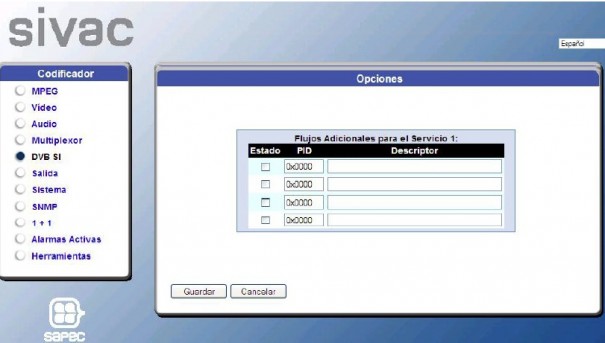Sapec will demonstrate the improvements in its Sivac line at NAB
Sapec's Sivac family of encoders and multiplexers now offer improvements such as the inclusion of external synchronization in decoders and adding audio to an existing service in multiplexers.
Sapec, coinciding with NAB 2011, will present some improvements in the models of multiplexers and MPEG-2 encoders and decoders in standard definition (SD) of the Sivac family.
The new models allow you to choose synchronism from one of the following three sources: recovered (PCR that is transmitted by the Transport Stream), local (internal reference in the decoder) and genlock (external synchronization signal). In the latter case, it is possible to adjust the signal horizontally -pixels- or vertically -lines-. If the sync signal fails, the decoder will choose one of the other sources that has been configured as secondary (recovery or local).
Another novelty in the Sivac decoder is the management of the test lines (VITS) in the video output, through two operating modes: “Auto” (the SIVAC decoder inserts test lines if the input signal does not include them. In If it has them, it lets them pass) and “No” (the decoder does not insert test lines if the input signal does not include them. If it has them, it lets them pass).
Aspect ratio management
Aspect ratio management has been improved in both SIVAC encoders and decoders. In Sivac encoders you can signal the aspect ratio of the video signal following the Wide Screen Signaling (WSS) or Active Format Description (AFD) standards in both versions VI (Vertical Interval) and SS (Screen Signaling) or force it directly to 4:3 or 16:9. For its part, in SIVAC decoders, the aspect ratio information of the input signal can be recoded into the AFD, WSS format, or both, or passed through in the same input format.
Sapec has also perfected the feature of which output to display in case there is no input signal on the Sivac decoder. It is now possible to select: “No video” (no signal), black output (both 525 and 625 lines) or vertical stripe pattern output (both 525 and 625 lines).
In Sivac encoders, the possibility of generating the signaling of up to four additional services (subtitles, RDS, private data...) has been incorporated to those generated by the encoder itself, adding the PID and the descriptor for each of the four PMT's that is capable of generating the encoder. Thus, it is possible to create a video service with audio and up to three additional audio services (radios) signaled separately, a feature that has been widely used in digital terrestrial television (DTT) headends.
Multiplexores MTS
On the other hand, the MTS multiplexers of the SIVAC family offer the possibility of embedding audio services within another service, so that, for example, it would be possible to add additional languages to an existing audio television service.
It is also possible to analyze the bitrate of each of the inputs individually and set alarms on it (input peaks, absence of signal) so that it is possible to monitor incidents in the input flow.
In the MTS-1400 model, the functionality of virtual outputs has been increased, from 4 to 8, so that it is possible to establish up to 8 different output configurations depending on the alarm or error conditions that occur at the input.
SIVAC equipment, with a consolidated presence in the market, are MPEG-2 SD encoders and decoders designed and manufactured by SAPEC for television signal contribution and distribution applications that come in three formats: SIVAC 1000 (1RU units with front panel configuration), SIVAC 2000 (2RU modular units with capacity for up to 4 encoder/decoder cards) and SIVAC 3000 (1RU units without front configuration panel).
The MTS-1000 and MTS-1400 multiplexers of the SIVAC family are devices capable of combining up to 8 Transport Stream inputs (MPTS or SPTS) and provide the necessary tools for the formation and manipulation of the output stream, including the manipulation of each PID. in an independent way. They support MPEG, DVD and ATSC standards. The MTS-1400 model also supports switching in the output configuration in case of error or failure at the input.
Did you like this article?
Subscribe to our RSS feed and you won't miss anything.















